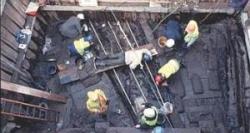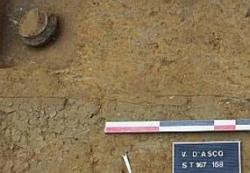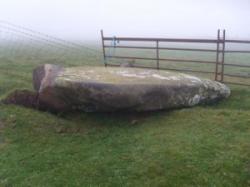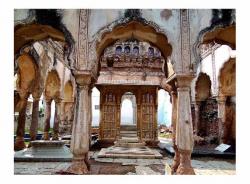15 OCTOBRE
INDI-UNI : ANTHROPOLOGY - ARCHAEOLOGY
INSCRIPTION 2011 – 2012 COURS A DISTANCE
REGISTRATION 2011 – 2012 ONLINE COURSES
ROYAUME UNI –  Douvres - En septembre 1992, lors de travaux urbains dans le port de Douvres, des archéologues interviennent dans le cadre d'une fouille préventive. Ils mettent au jour des planches de chêne soigneusement assemblées par des liens végétaux. Sous six mètres de sédiments, ses matières organiques ont été exceptionnellement conservées. Une extrémité d'embarcation apparaît. C'est un bateau, conservé sur un peu plus de 9 m de long. Une opération d'envergure est organisée pour le dégager soigneusement, puis pour l'extraire de ce lieu où il repose depuis 3 500 ans ! En effet, une datation radiocarbone livre cet incroyable résultat : il s'agit d'un des plus vieux bateaux maritimes d'Europe. Des pirogues fluviales du Néolithique sont connues dès le 4e millénaire avant Jésus-Christ. En revanche, les preuves d'une navigation maritime pour ces périodes si anciennes restaient à découvrir. Les archéologues savent que les hommes entrent en contact de part et d'autre du Channel. Les objets, les types de maisons ou de tombes similaires le montrent. D'ailleurs, depuis le développement de l'archéologie préventive au début des années 2000, les preuves de ce type se multiplient en France, dans le sud de l'Angleterre et en Belgique. Le bateau de Douvres constitue donc un lien matériel et symbolique de ces échanges à une époque, l'Age de bronze, où les frontières se situaient à l'arrière des côtes et où la mer n'était pas un obstacle mais un lieu de passage quotidien - bien avant notre tunnel contemporain - autour duquel se rassemblait une communauté transmanche. L'enquête est longue, difficile, passionnante. Au terme de 15 ans de recherches internationales, les archéologues sont en mesure de proposer une restitution du bateau et d'en envisager une réplique dans le cadre d'une archéologie expérimentale. Ils souhaitent même aller plus loin et lancer un vaste projet qui raconte une histoire méconnue des côtes de la Manche et de la mer du Nord il y a 3 500 ans et qui replace l'idée d'une Eurorégion sur la longue durée.C'est ainsi que naît le projet Boat 1 550 BC, soutenu par l'Union européenne, conduit par les archéologues de trois pays (France, Angleterre, Belgique).
Douvres - En septembre 1992, lors de travaux urbains dans le port de Douvres, des archéologues interviennent dans le cadre d'une fouille préventive. Ils mettent au jour des planches de chêne soigneusement assemblées par des liens végétaux. Sous six mètres de sédiments, ses matières organiques ont été exceptionnellement conservées. Une extrémité d'embarcation apparaît. C'est un bateau, conservé sur un peu plus de 9 m de long. Une opération d'envergure est organisée pour le dégager soigneusement, puis pour l'extraire de ce lieu où il repose depuis 3 500 ans ! En effet, une datation radiocarbone livre cet incroyable résultat : il s'agit d'un des plus vieux bateaux maritimes d'Europe. Des pirogues fluviales du Néolithique sont connues dès le 4e millénaire avant Jésus-Christ. En revanche, les preuves d'une navigation maritime pour ces périodes si anciennes restaient à découvrir. Les archéologues savent que les hommes entrent en contact de part et d'autre du Channel. Les objets, les types de maisons ou de tombes similaires le montrent. D'ailleurs, depuis le développement de l'archéologie préventive au début des années 2000, les preuves de ce type se multiplient en France, dans le sud de l'Angleterre et en Belgique. Le bateau de Douvres constitue donc un lien matériel et symbolique de ces échanges à une époque, l'Age de bronze, où les frontières se situaient à l'arrière des côtes et où la mer n'était pas un obstacle mais un lieu de passage quotidien - bien avant notre tunnel contemporain - autour duquel se rassemblait une communauté transmanche. L'enquête est longue, difficile, passionnante. Au terme de 15 ans de recherches internationales, les archéologues sont en mesure de proposer une restitution du bateau et d'en envisager une réplique dans le cadre d'une archéologie expérimentale. Ils souhaitent même aller plus loin et lancer un vaste projet qui raconte une histoire méconnue des côtes de la Manche et de la mer du Nord il y a 3 500 ans et qui replace l'idée d'une Eurorégion sur la longue durée.C'est ainsi que naît le projet Boat 1 550 BC, soutenu par l'Union européenne, conduit par les archéologues de trois pays (France, Angleterre, Belgique).
http://www.lavenirdelartois.fr/actualite/Pas-de-Calais/Cote_d_Opale/article_1471600.shtml
FRANCE –  Villeneuve d’Ascq - Du 21 au 29 mars dernier, une équipe d'archéologues menait un diagnostic dans le cadre du projet de reconstruction de l'IEM Marc-Sautelet. Quelle ne fut pas sa surprise de tomber sur une découverte majeure : une nécropole de la fin du IVe siècle. Certes, les archéologues savaient bien qu'ils se trouvaient en terre largement occupée au cours des siècles puisqu'un squelette avait été mis au jour dans le secteur en 1969. Ces résultat ont conduit la Cira (Commission interrégionale de la recherche archéologique) à préconiser à la fois des mesures de conservation (pour la nécropole) et d'investigation pour le reste de la parcelle. Autrement dit sur les 6 000 m² de la parcelle concernée, un tiers sera sanctuarisé en vue de fouilles ultérieures plus approfondies, le reste doit faire l'objet d'une fouille préventive avant travaux. Pour la première partie, aucune échéance n'a été fixée, il s'agit d'une mesure de préservation car la fouille coûtera très cher, les archéologues estimant être potentiellement confrontés à plusieurs centaines de tombes. Pour la deuxième partie, il pourrait s'agir de fouilles plus « classiques », les diagnostics ne laissent pas supposer de découvertes majeures. Il n'empêche, cette opération aura un coût à la charge du propriétaire, comme le prévoit la législation, à savoir l'IEM Marc-Sautelet.
Villeneuve d’Ascq - Du 21 au 29 mars dernier, une équipe d'archéologues menait un diagnostic dans le cadre du projet de reconstruction de l'IEM Marc-Sautelet. Quelle ne fut pas sa surprise de tomber sur une découverte majeure : une nécropole de la fin du IVe siècle. Certes, les archéologues savaient bien qu'ils se trouvaient en terre largement occupée au cours des siècles puisqu'un squelette avait été mis au jour dans le secteur en 1969. Ces résultat ont conduit la Cira (Commission interrégionale de la recherche archéologique) à préconiser à la fois des mesures de conservation (pour la nécropole) et d'investigation pour le reste de la parcelle. Autrement dit sur les 6 000 m² de la parcelle concernée, un tiers sera sanctuarisé en vue de fouilles ultérieures plus approfondies, le reste doit faire l'objet d'une fouille préventive avant travaux. Pour la première partie, aucune échéance n'a été fixée, il s'agit d'une mesure de préservation car la fouille coûtera très cher, les archéologues estimant être potentiellement confrontés à plusieurs centaines de tombes. Pour la deuxième partie, il pourrait s'agir de fouilles plus « classiques », les diagnostics ne laissent pas supposer de découvertes majeures. Il n'empêche, cette opération aura un coût à la charge du propriétaire, comme le prévoit la législation, à savoir l'IEM Marc-Sautelet.
http://www.nordeclair.fr/Locales/Villeneuve-d-Ascq/2011/10/14/les-fouilles-contrarient-le-projet-d-ext.shtml
THAILANDE – Ayutthaya - The UN cultural organisation Unesco said on Thursday it would launch a mission to the ancient Thai city of Ayutthaya to assess the damage to the World Heritage site from the worst floods in decades.
http://www.news24.com/World/News/Unesco-mission-heads-to-Thai-site-20111013
ROYAUME UNI –  Bedd Morris - An ancient monument has crashed to the ground after standing for more than 4,000 years as an important landmark. The famous standing stone at Bedd Morris, on Newport mountain, was snapped over the weekend, toppling over and crushing a nearby fence. It is believed the two metre high, bronze age stone was hit by a vehicle travelling on the Cwm Gwaun to Newport road.
Bedd Morris - An ancient monument has crashed to the ground after standing for more than 4,000 years as an important landmark. The famous standing stone at Bedd Morris, on Newport mountain, was snapped over the weekend, toppling over and crushing a nearby fence. It is believed the two metre high, bronze age stone was hit by a vehicle travelling on the Cwm Gwaun to Newport road.
http://www.westerntelegraph.co.uk/news/9303748.4_000_years_of_history_crashes_to_the_ground/
CHINE – 
 Anhui - A West Asian dragonfly-eye-shaped bead was found in a 2,000-odd-year Chinese tomb in Dangtu, Anhui province, indicating noblemen living in China's Warring States period (475 BC-221BC) were exposed to West Asian civilization. Excavated from the roughly 400-sqm tomb were more than 40 cultural relics, of which most were potteries and celadon wares. Judging from those possessions, the occupant is expected to be an aristocrat of Yue, one of the seven major countries in the Warring States period, archaeologists said. The most eye-catching burial object is a glass bead resembling a dragonfly eye in appearance. Such kind of jewellery was made by nomadic tribes in Mediterranean countries in the 10th century BC and believed to keep misfortune away from the wearers as well as to play the role of money, Gong Xicheng, deputy director of the provincial archaeological institute said. Much contact between nomadic tribes of West Asia and China enabled the dragonfly-eye-shaped jewellery to take off in Chinese privileged class in the Warring States period, Gong said.
Anhui - A West Asian dragonfly-eye-shaped bead was found in a 2,000-odd-year Chinese tomb in Dangtu, Anhui province, indicating noblemen living in China's Warring States period (475 BC-221BC) were exposed to West Asian civilization. Excavated from the roughly 400-sqm tomb were more than 40 cultural relics, of which most were potteries and celadon wares. Judging from those possessions, the occupant is expected to be an aristocrat of Yue, one of the seven major countries in the Warring States period, archaeologists said. The most eye-catching burial object is a glass bead resembling a dragonfly eye in appearance. Such kind of jewellery was made by nomadic tribes in Mediterranean countries in the 10th century BC and believed to keep misfortune away from the wearers as well as to play the role of money, Gong Xicheng, deputy director of the provincial archaeological institute said. Much contact between nomadic tribes of West Asia and China enabled the dragonfly-eye-shaped jewellery to take off in Chinese privileged class in the Warring States period, Gong said.
http://english.anhuinews.com/system/2011/10/12/004484612.shtml
INDE –  Naduvirapattu - Ancient Romans did not restrict themselves to coastal Tamil Nadu; they set up trading centres even far inland. A team of archaeologists exploring a dry lake bed in Naduvirapattu village, some 12km from Tambaram, unearthed a few days ago some artefacts, including broken pieces of amphorae (jars used by Romans). The evidence at the site, archaeologists said, was a sign that the village may have been a transit staging area for the Romans before they proceeded towards Kancheepuram, a famous trading centre since the pre-historic era, to exchange their glass utensils and wine for rice, sesame oil, spices and silk. In fact, they said, the pieces of amphorae were clear evidence of the presence of Romans. Earlier, similar jars had been found at excavation sites in Kancheepuram, Vasavasamudram and Arikamedu near Puducherry. These sites are located near the shore or river (Kancheepuram is near the Palar river), but Naduvirapattu is far from the coast or a river. "The findings are interesting because the site is between two towns - Somangalam and Manimangalam - important since the pre-historic era," said former deputy superintending archaeologist K Sridharan. It was a tip by a villager, engaged in sand-mining on a dry lake bed, that took the team to the site where it found artefacts of the Sangam Age (between 3rd century BCE and 4th century CE) and some from ancient Rome. Among them, the archaeologists said, were black-and-red ware, black ware, red slipped ware, double slipped ware, broken handles of vessels, hopscotch and lid knob. We also found two shreds that formed the base of a conical jar. The conical jar is an imitation of the Romans' amphorae and is indigenously made," said assistant professor Koshy. Also found was an old brick structure, reportedly from the Sangam Age. Each brick, it was found, was 31cm long, 20.5cm wide and 7.5cm thick. The dry lake bed is being exploited by sand miners with earth movers, the archaeologists said, adding that unless checked it could destroy rare evidence to trace the cultural history from the early historic period or Sangam Age. The site should be preserved for further research and excavation that could help throw light on the importance of the village during the Sangam Age, structural activities and trade contacts during the Age.
Naduvirapattu - Ancient Romans did not restrict themselves to coastal Tamil Nadu; they set up trading centres even far inland. A team of archaeologists exploring a dry lake bed in Naduvirapattu village, some 12km from Tambaram, unearthed a few days ago some artefacts, including broken pieces of amphorae (jars used by Romans). The evidence at the site, archaeologists said, was a sign that the village may have been a transit staging area for the Romans before they proceeded towards Kancheepuram, a famous trading centre since the pre-historic era, to exchange their glass utensils and wine for rice, sesame oil, spices and silk. In fact, they said, the pieces of amphorae were clear evidence of the presence of Romans. Earlier, similar jars had been found at excavation sites in Kancheepuram, Vasavasamudram and Arikamedu near Puducherry. These sites are located near the shore or river (Kancheepuram is near the Palar river), but Naduvirapattu is far from the coast or a river. "The findings are interesting because the site is between two towns - Somangalam and Manimangalam - important since the pre-historic era," said former deputy superintending archaeologist K Sridharan. It was a tip by a villager, engaged in sand-mining on a dry lake bed, that took the team to the site where it found artefacts of the Sangam Age (between 3rd century BCE and 4th century CE) and some from ancient Rome. Among them, the archaeologists said, were black-and-red ware, black ware, red slipped ware, double slipped ware, broken handles of vessels, hopscotch and lid knob. We also found two shreds that formed the base of a conical jar. The conical jar is an imitation of the Romans' amphorae and is indigenously made," said assistant professor Koshy. Also found was an old brick structure, reportedly from the Sangam Age. Each brick, it was found, was 31cm long, 20.5cm wide and 7.5cm thick. The dry lake bed is being exploited by sand miners with earth movers, the archaeologists said, adding that unless checked it could destroy rare evidence to trace the cultural history from the early historic period or Sangam Age. The site should be preserved for further research and excavation that could help throw light on the importance of the village during the Sangam Age, structural activities and trade contacts during the Age.
http://timesofindia.indiatimes.com/Chennais-links-to-ancient-Rome-found/articleshow/10348895.cms
INDE –  Hyderabad - The Kalyani Nawab ki Devdi, Maqbara Kalyani Nawab near Mughalpura in the old city, is unique in that it has elements of Mughal and Asaf Jahi architecture, say historians and archaeologists. But it has not found a place in the state archaeological list of protected monuments. According famous historian and archaeologist M.A. Qaiyum, there were many nawabs under the Nizam’s regime in different places in the erstwhile state of Hyderabad, and one of them was Kalyani Nawab. Kalyani Nawab came from Kalyani in Bidar, where there is a fort called Kalyani Nawab ka Qila. He came to Hyderabad in the late 18th century and was residing in Mughalpura. His residence was known as Kalyani Nawab Ki Devdi and when he died, he was buried in the same residence, so later the place was known as Maqbara Kalyani Nawab. “The Maqbara Kalyani Nawab is a unique mixture of Mughal-Asaf Jahi architecture. It has a colourful flooring and unique patterns on the wall. It’s a one of its kind in the city,” says Mr Qaiyum.
Hyderabad - The Kalyani Nawab ki Devdi, Maqbara Kalyani Nawab near Mughalpura in the old city, is unique in that it has elements of Mughal and Asaf Jahi architecture, say historians and archaeologists. But it has not found a place in the state archaeological list of protected monuments. According famous historian and archaeologist M.A. Qaiyum, there were many nawabs under the Nizam’s regime in different places in the erstwhile state of Hyderabad, and one of them was Kalyani Nawab. Kalyani Nawab came from Kalyani in Bidar, where there is a fort called Kalyani Nawab ka Qila. He came to Hyderabad in the late 18th century and was residing in Mughalpura. His residence was known as Kalyani Nawab Ki Devdi and when he died, he was buried in the same residence, so later the place was known as Maqbara Kalyani Nawab. “The Maqbara Kalyani Nawab is a unique mixture of Mughal-Asaf Jahi architecture. It has a colourful flooring and unique patterns on the wall. It’s a one of its kind in the city,” says Mr Qaiyum.
http://www.deccanchronicle.com/channels/cities/hyderabad/monumental-neglect-unique-architecture-569